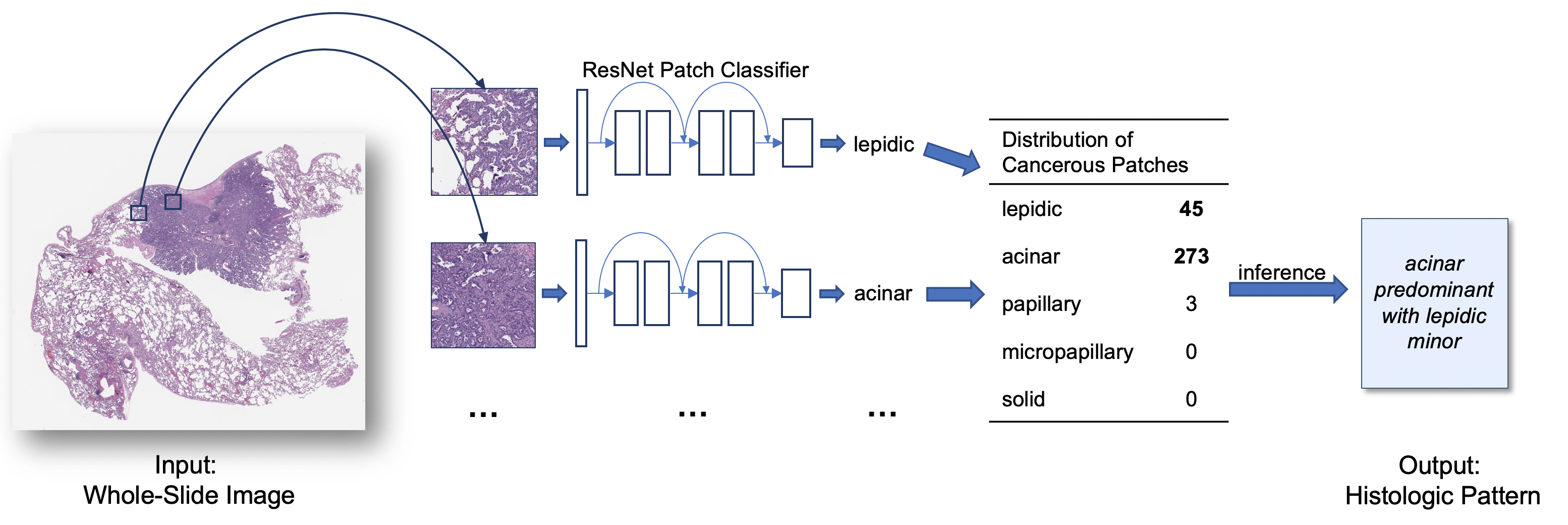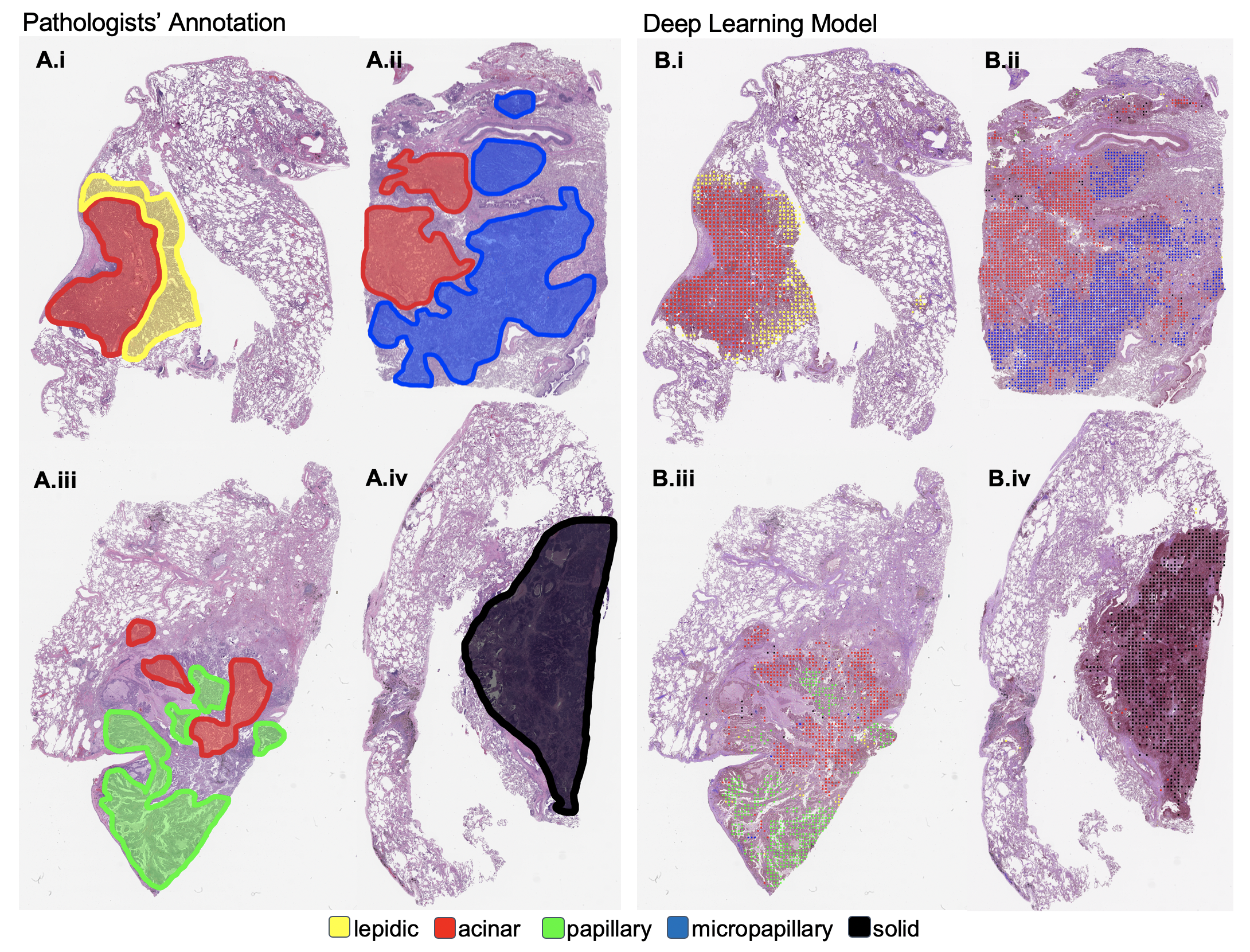BMIRDS / Deepslide
Programming Languages
Labels
Projects that are alternatives of or similar to Deepslide
DeepSlide: A Sliding Window Framework for Classification of High Resolution Microscopy Images (Whole-Slide Images)
This repository is a sliding window framework for classification of high resolution whole-slide images, often called microscopy or histopathology images. This is also the code for the paper Pathologist-level Classification of Histologic Patterns on Resected Lung Adenocarcinoma Slides with Deep Neural Networks. For a practical guide and implementation tips, see the Medium post Classification of Histopathology Images with Deep Learning: A Practical Guide.
We have made 143 digitized high-resolution histology slides of lung adenocarcinoma in the test set and their predominant subtypes according to the consensus opinion of three pathologists at Dartmouth-Hitchcock Medical Center publicly available. More information about this dataset and instructions on how to download are provided on the dataset webpage.
For questions about our code, please open an issue on this code repository.
Requirements
- imageio
- NumPy 1.16
- OpenCV
- OpenSlide
- OpenSlide Python
- pandas
- PIL
- Python 3.6
- PyTorch
- scikit-image
- scikit-learn
- SciPy
- NVIDIA GPU
- Ubuntu
Usage
Take a look at code/config.py before you begin to get a feel for what parameters can be changed.
1. Train-Val-Test Split:
Splits the data into a validation and test set. Default validation whole-slide images (WSI) per class is 20 and test images per class is 30. You can change these numbers by changing the --val_wsi_per_class and --test_wsi_per_class flags at runtime. You can skip this step if you did a custom split (for example, you need to split by patients).
python code/1_split.py
If you do not want to duplicate the data, append --keep_orig_copy False to the above command.
Inputs: all_wsi
Outputs: wsi_train, wsi_val, wsi_test, labels_train.csv, labels_val.csv, labels_test.csv
Note that all_wsi must contain subfolders of images labeled by class. For instance, if your two classes are a and n, you must have a/*.jpg with the images in class a and n/*.jpg with images in class n.
Example
python code/1_split.py --val_wsi_per_class 10 --test_wsi_per_class 20
2. Data Processing
- Generate patches for the training set.
- Balance the class distribution for the training set.
- Generate patches for the validation set.
- Generate patches by folder for WSI in the validation set.
- Generate patches by folder for WSI in the testing set.
python code/2_process_patches.py
Note that this will take up a significant amount of space. Change --num_train_per_class to be smaller if you wish not to generate as many windows. If your histopathology images are H&E-stained, whitespace will automatically be filtered. Turn this off using the option --type_histopath False. Default overlapping area is 1/3 for test slides. Use 1 or 2 if your images are very large; you can also change this using the --slide_overlap option.
Inputs: wsi_train, wsi_val, wsi_test
Outputs: train_folder (fed into model for training), patches_eval_train (for validation, sorted by WSI), patches_eval_test (for testing, sorted by WSI)
Example
python code/2_process_patches.py --num_train_per_class 20000 --slide_overlap 2
3. Model Training
CUDA_VISIBLE_DEVICES=0 python code/3_train.py
We recommend using ResNet-18 if you are training on a relatively small histopathology dataset. You can change hyperparameters using the argparse flags. There is an option to retrain from a previous checkpoint. Model checkpoints are saved by default every epoch in checkpoints.
Inputs: train_folder
Outputs: checkpoints, logs
Example
CUDA_VISIBLE_DEVICES=0 python code/3_train.py --batch_size 32 --num_epochs 100 --save_interval 5
4. Testing on WSI
Run the model on all the patches for each WSI in the validation and test set.
CUDA_VISIBLE_DEVICES=0 python code/4_test.py
We automatically choose the model with the best validation accuracy. You can also specify your own. You can change the thresholds used in the grid search by specifying the threshold_search variable in code/config.py.
Inputs: patches_eval_val, patches_eval_test
Outputs: preds_val, preds_test
Example
CUDA_VISIBLE_DEVICES=0 python code/4_test.py --auto_select False
5. Searching for Best Thresholds
The simplest way to make a whole-slide inference is to choose the class with the most patch predictions. We can also implement thresholding on the patch level to throw out noise. To find the best thresholds, we perform a grid search. This function will generate csv files for each WSI with the predictions for each patch.
python code/5_grid_search.py
Inputs: preds_val, labels_val.csv
Outputs: inference_val
Example
python code/5_grid_search.py --preds_val different_labels_val.csv
6. Visualization
A good way to see what the network is looking at is to visualize the predictions for each class.
python code/6_visualize.py
Inputs: wsi_val, preds_val
Outputs: vis_val
You can change the colors in colors in code/config.py
Example
python code/6_visualize.py --vis_test different_vis_test_directory
7. Final Testing
Do the final testing to compute the confusion matrix on the test set.
python code/7_final_test.py
Inputs: preds_test, labels_test.csv, inference_val and labels_val (for the best thresholds)
Outputs: inference_test and confusion matrix to stdout
Example
python code/7_final_test.py --labels_test different_labels_test.csv
Best of luck.
Quick Run
If you want to run all code and change the default parameters in code/config.py, run
sh code/run_all.sh
and change the desired flags on each line of the code/run_all.sh script.
Pre-Processing Scripts
See code/z_preprocessing for some code to convert images from svs into jpg. This uses OpenSlide and takes a while. How much you want to compress images will depend on the resolution that they were originally scanned, but a guideline that has worked for us is 3-5 MB per WSI.
Known Issues and Limitations
- Only 1 GPU supported.
- Should work, but not tested on Windows.
- In cases where no crops are found for an image, empty directories are created. Current workaround uses
tryandexceptstatements to catch errors. - Image reading code expects colors to be in the RGB space. Current workaround is to keep first 3 channels.
- This code will likely work better when the labels are at the tissue level. It will still work for the entire WSI, but results may vary.
Still not working? Consider the following...
- Ask a pathologist to look at your visualizations.
- Make your own heuristic for aggregating patch predictions to determine the WSI-level classification. Often, a slide thats 20% abnormal and 80% normal should be classified as abnormal.
- If each WSI can have multiple types of lesions/labels, you may need to annotate bounding boxes around these.
- Did you pre-process your images? If you used raw .svs files that are more than 1GB in size, its likely that the patches are way too zoomed in to see any cell structures.
- If you have less than 10 WSI per class in the training set, obtain more.
- Feel free to view our end-to-end attention-based model in JAMA Network Open: https://jamanetwork.com/journals/jamanetworkopen/fullarticle/2753982.
Future Work
- Contributions to this repository are welcome.
- Code for generating patches on the fly instead of storing them in memory for training and testing would save a lot of disk space.
- If you have issues, please post in the issues section and we will do our best to help.
Citations
DeepSlide is an open-source library and is licensed under the GNU General Public License (v3). If you are using this library please cite:
Jason Wei, Laura Tafe, Yevgeniy Linnik, Louis Vaickus, Naofumi Tomita, Saeed Hassanpour, "Pathologist-level Classification of Histologic Patterns on Resected Lung Adenocarcinoma Slides with Deep Neural Networks", Scientific Reports;9:3358 (2019).


